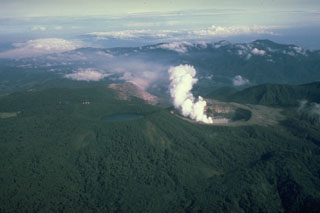Report on Poas (Costa Rica) — 12 March-18 March 2025
Smithsonian Institution / US Geological Survey
Weekly Volcanic Activity Report, 12 March-18 March 2025
Managing Editor: Sally Sennert.
Please cite this report as:
Global Volcanism Program, 2025. Report on Poas (Costa Rica) (Sennert, S, ed.). Weekly Volcanic Activity Report, 12 March-18 March 2025. Smithsonian Institution and US Geological Survey.
Poas
Costa Rica
10.2°N, 84.233°W; summit elev. 2697 m
All times are local (unless otherwise noted)
The Observatorio Vulcanológico y Sismológico de Costa Rica-Universidad Nacional (OVSICORI-UNA) reported that eruptive activity at Poás continued at an elevated level through 18 March. Four significant phreatic eruptions were recorded on 9 March that ejected material as high as 300 m above the lake’s surface and produced a steam-and-gas plume that rose 1 km. The monitoring network did not record eruptive events during 11-12 March. Sulfur dioxide emissions fluctuated; emissions detected in satellite data averaged 344 tons per day (t/d) on 11 March and 472 t/d on 12 March and relatively high concentrations were measured by a gas sensor located at the Visitor Observation Deck on 12 March. Residents in Grecia (16 km SW), Sarchí (18 km SW), and San Gertrudis (13 km SSW) reported a sulfur odor and minor ashfall.
A small phreatic eruption occurred at 0536 on 13 March, though continuous and voluminous emissions of steam and gas obscured views of the event. A sequence of small phreatic events was recorded during 1800-2000, culminating in a moderate phreatic eruption at 2000. A plume containing significant amounts of sulfur dioxide, hydrogen sulfide, and tephra drifted NW as far as the SW part of Nicaragua. Sulfur dioxide emissions detected in satellite data averaged 844 t/d. At 2300 instruments located at the visitor building of the Parque Nacional Volcán Poás recorded extreme levels of sulfur dioxide gas and particulates in the air; these conditions lasted until around 0300 on 14 March. During 0140-0200 on 14 March a gas monitoring station in San Isidro de Coronado measured high levels of sulfur dioxide gas from a plume that drifted S and E of the Valle Central. Residents of Heredia (28 km SE), Alajuela (21 km S), and San José (33 km SE) reported sulfur odors, minor ashfall, and adverse health effects like respiratory discomfort for both residents and animals. Gas-and-steam emissions continued from both Boca A and Boca C through 18 March. The Alert Level remained at 3 (the second highest level on a four-level scale) and the Aviation Color Code remained at Orange (the second highest color on a four-color scale).
Geological Summary. The broad vegetated edifice of Poás, one of the most active volcanoes of Costa Rica, contains three craters along a N-S line. The frequently visited multi-hued summit crater lakes of the basaltic-to-dacitic volcano are easily accessible by vehicle from the nearby capital city of San José. A N-S-trending fissure cutting the complex stratovolcano extends to the lower N flank, where it has produced the Congo stratovolcano and several lake-filled maars. The southernmost of the two summit crater lakes, Botos, last erupted about 7,500 years ago. The more prominent geothermally heated northern lake, Laguna Caliente, is one of the world's most acidic natural lakes, with a pH of near zero. It has been the site of frequent phreatic and phreatomagmatic eruptions since an eruption was reported in 1828. Eruptions often include geyser-like ejections of crater-lake water.
Source: Observatorio Vulcanologico y Sismologico de Costa Rica-Universidad Nacional (OVSICORI-UNA)

